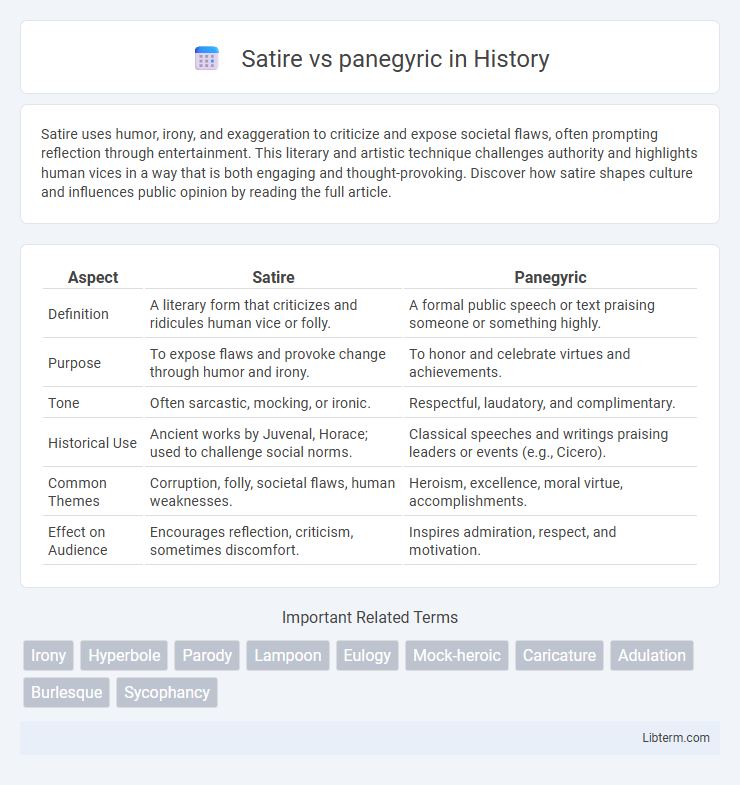Satire uses humor, irony, and exaggeration to criticize and expose societal flaws, often prompting reflection through entertainment. This literary and artistic technique challenges authority and highlights human vices in a way that is both engaging and thought-provoking. Discover how satire shapes culture and influences public opinion by reading the full article.
Table of Comparison
| Aspect | Satire | Panegyric |
|---|---|---|
| Definition | A literary form that criticizes and ridicules human vice or folly. | A formal public speech or text praising someone or something highly. |
| Purpose | To expose flaws and provoke change through humor and irony. | To honor and celebrate virtues and achievements. |
| Tone | Often sarcastic, mocking, or ironic. | Respectful, laudatory, and complimentary. |
| Historical Use | Ancient works by Juvenal, Horace; used to challenge social norms. | Classical speeches and writings praising leaders or events (e.g., Cicero). |
| Common Themes | Corruption, folly, societal flaws, human weaknesses. | Heroism, excellence, moral virtue, accomplishments. |
| Effect on Audience | Encourages reflection, criticism, sometimes discomfort. | Inspires admiration, respect, and motivation. |
Introduction to Satire and Panegyric
Satire employs humor, irony, or exaggeration to criticize and expose flaws in individuals, society, or politics, often aiming to provoke change or reflection. Panegyric, by contrast, offers formal and elaborate praise of a person, event, or entity, emphasizing virtues and accomplishments. Understanding these contrasting rhetorical forms highlights how language serves both to challenge and celebrate human behavior and achievements.
Defining Satire: Purpose and Techniques
Satire is a literary genre aimed at exposing and criticizing human folly, vices, or social institutions through humor, irony, and exaggeration, intending to provoke change or reflection. Common techniques include parody, sarcasm, and caricature, which highlight contradictions and absurdities in behavior or ideology. Unlike panegyric, which praises and idealizes its subject, satire operates by revealing flaws to encourage improvement or awareness.
Understanding Panegyric: Praise and Its Forms
Panegyric is a literary form dedicated to high praise, often highlighting the virtues, achievements, or qualities of a person, event, or entity in a formal and elaborate manner. It serves as a rhetorical tool to elevate and honor its subject through exalted language and structured praise, commonly found in speeches, poems, and written encomiums. Understanding panegyric involves recognizing its intent to celebrate and glorify, contrasting sharply with satire's use of humor and critique to expose flaws or vices.
Historical Origins of Satire and Panegyric
Satire originated in ancient Rome as a literary genre used by poets like Juvenal and Horace to criticize societal vices through humor and irony, while panegyric dates back to classical Greece, where orators such as Isocrates crafted elaborate speeches praising individuals or gods. Satire's function was to expose faults and provoke reform, contrasting with panegyric's goal of admiration and celebration. The historical development of these forms reflects their opposing purposes: satire as social commentary and panegyric as rhetorical exaltation.
Key Differences Between Satire and Panegyric
Satire employs humor, irony, and exaggeration to criticize and expose flaws in individuals, institutions, or societal norms, aiming to provoke change or reflection. Panegyric, in contrast, is a formal expression of praise that highlights virtues and accomplishments, often used to honor a person or event. The key difference lies in their intent: satire seeks to challenge and correct, while panegyric aims to celebrate and laud.
Social and Cultural Impacts
Satire exposes social flaws and cultural absurdities by using humor and irony to provoke critical thinking and reform, challenging established norms and prompting societal self-reflection. Panegyric, through elaborate praise and idealization, reinforces cultural values and unites communities by celebrating shared virtues and historical achievements. Both forms shape public discourse, with satire fostering skepticism and change, while panegyric cultivates admiration and social cohesion.
Notable Examples in Literature
Jonathan Swift's "Gulliver's Travels" exemplifies satire by using irony and exaggeration to critique human nature and society, while John Milton's "Paradise Lost" serves as a panegyric that glorifies divine providence and heroic sacrifice. Voltaire's "Candide" delivers biting satire through absurdity and wit, contrasting with Alexander Pope's "An Essay on Man," which praises human reason and order in a panegyric tone. These works highlight the stark differences between satire's critical edge and panegyrics' celebratory style in literary tradition.
Satire and Panegyric in Modern Media
Satire in modern media serves as a powerful tool for social and political critique, using humor, irony, and exaggeration to expose flaws and provoke thought among audiences. Panegyric, though less prevalent, appears in contemporary media as laudatory commentary, often highlighting achievements and virtues in political speeches, documentaries, and brand endorsements. The juxtaposition of satire and panegyric reflects the dynamic spectrum of media discourse, balancing criticism with praise in shaping public perception.
Ethical Considerations and Misuse
Satire employs irony, sarcasm, and exaggeration to critique societal flaws, demanding careful ethical consideration to avoid harm or misrepresentation of subjects. Panegyric, as a formal expression of praise, risks ethical misuse by fostering bias or overlooking shortcomings, potentially leading to insincerity or propaganda. Both genres require responsible use to maintain integrity, avoiding manipulation that can distort truth or offend audiences.
Conclusion: The Enduring Relevance
Satire and panegyric remain vital literary tools, reflecting society's complexities through critique and praise. Their enduring relevance lies in influencing public opinion and shaping cultural narratives by highlighting flaws and virtues. Both forms continue to engage audiences, fostering critical thinking and appreciation for diverse perspectives.
Satire Infographic

 libterm.com
libterm.com